Overview
This article serves as a comprehensive guide for organizations aiming to implement federated data governance effectively. It highlights the critical need for decentralized information management, detailing essential principles such as:
- Information ownership
- Decentralization
- Cooperation
Moreover, it outlines significant benefits, including:
- Increased agility
- Enhanced information quality
- Cost efficiency
By establishing a robust framework for successful implementation, this guide empowers organizations to navigate the complexities of data governance with confidence. Are you ready to transform your data management strategy?
Introduction
In an increasingly data-driven world, organizations are recognizing the critical importance of effective data governance strategies. But how can businesses navigate the complexities of regulatory compliance while remaining agile? Federated data governance has emerged as a compelling approach. This decentralized model empowers individual business units to manage their data while aligning with overarching governance policies, fostering accountability and collaboration.
By exploring key concepts such as:
- Data ownership
- Decentralization
- The evolving roles within data teams
organizations can harness the benefits of federated governance. From enhancing data quality to driving significant returns on investment, understanding this framework is essential for organizations striving to optimize their data management practices and seize the opportunities of the future.
Understanding Federated Data Governance: Key Concepts and Definitions
Federated information management represents a decentralized strategy for managing information across various sectors within a company. This approach empowers individual business units to retain control over their data while complying with overarching regulatory policies. As we move into 2025, the significance of this method is increasingly recognized, with organizations understanding the critical need for agility and responsiveness in their information management practices. Key principles of decentralized information management include:
- Information Ownership: Each domain within the organization appoints specific owners tasked with ensuring quality and compliance. This ownership fosters accountability and encourages proactive management of information assets.
- Decentralization: In contrast to centralized management models, distributed oversight allows local teams to make informed decisions regarding their information. This autonomy facilitates quicker responses to business needs and enhances operational efficiency.
- Cooperation: Effective distributed management hinges on strong collaboration between central regulatory bodies and local teams. This partnership ensures that local initiatives align with organizational goals while adhering to regulatory standards.
The benefits of implementing federated data management are substantial. Organizations investing in quality management report returns on investment ranging from 30% to 500% within just 18 to 24 months. This underscores the financial advantages of viewing information management as a business necessity rather than a burden.
Moreover, the evolution of the modern information stack towards a self-service model is reshaping roles within analytics teams. As organizations embrace collaborative oversight, critical positions such as Data Architect and Quality Analyst are becoming increasingly vital, signifying a shift towards management and self-service functionalities. However, achieving complete independence for business users remains a challenge, highlighting the ongoing need for collaboration and support.
In the finance sector, federated data management and information contracts are crucial for maintaining compliance while allowing for independent operations. Striking this balance is essential for organizations aiming to leverage their information resources effectively while navigating complex regulatory landscapes. As Michael Bass aptly states, ‘The path forward is clear: treat information management not as a burden, but as a business imperative and opportunity.’
Furthermore, in 2025, the ability to make data-driven decisions, reduce costs, and enhance efficiency emerges as key opportunities for organizations. Understanding these principles is vital for executing a successful collaborative information management strategy that meets the demands of today’s information-centric environment.
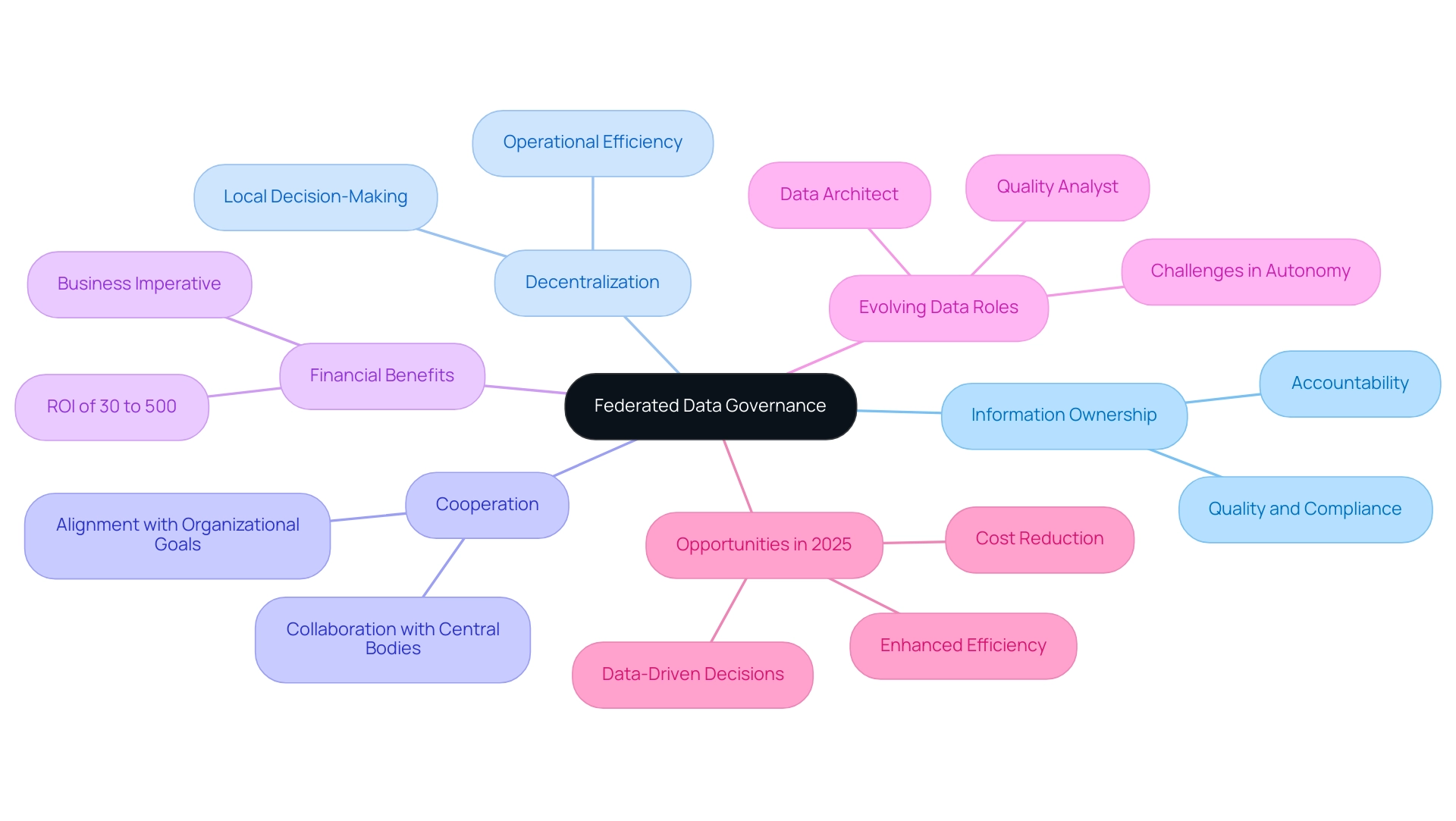
Federated vs. Centralized Data Governance: Choosing the Right Approach
When selecting between distributed and centralized information management, organizations must thoughtfully evaluate their specific requirements and operational environments.
Centralized Management: This method consolidates information oversight under a single team, promoting uniformity and consistency across the organization. However, it can lead to slower responsiveness to local needs and may hinder agility in decision-making related to federated data. In 2025, challenges related to centralized administration include a lack of flexibility in adapting to swiftly changing business environments and the potential for bottlenecks in information access.
Distributed Management: In contrast, distributed management shares information oversight responsibilities across various domains or departments. This model enhances responsiveness and allows for quicker decision-making tailored to specific business requirements. Organizations with varied information sources and different compliance requirements often find it more beneficial to use federated data for oversight. For instance, Porto reported a 40% rise in the effectiveness of its information management team after adopting a collaborative model, highlighting the concrete advantages of this strategy.
When assessing which management model to adopt, organizations should take into account elements such as information complexity, regulatory obligations, and their operational framework in relation to federated data. Expert views in 2025 indicate that decentralized management is progressively preferred for its capacity to adjust to local circumstances while preserving overall information integrity. Furthermore, as emphasized in recent conversations, 54% of industry experts recognize data oversight as a crucial challenge, second only to data quality, highlighting the significance of choosing the appropriate regulatory framework to ensure effective data management.
Avato’s dependable, future-ready technology stack, designed for integration projects needing 24/7 uptime, further assists organizations in adjusting to evolving demands, making it an appealing option for those contemplating a collaborative management model. Moreover, Avato sets itself apart through its speed, security, and ease of integration, featuring its ’12 levels of interface maturity,’ which can greatly improve the effectiveness of a collaborative approach, ultimately enabling businesses to future-proof their operations.

The Advantages of Federated Data Governance for Organizations
Adopting a federated data governance model offers numerous advantages that can significantly enhance organizational performance, particularly when leveraging Avato’s dedicated hybrid integration platform.
- Increased Agility: Local teams gain the ability to swiftly adapt to evolving data requirements and regulatory changes, thereby boosting overall organizational agility. This responsiveness is crucial in today’s fast-paced business environment, where the ability to pivot quickly can determine success. Avato’s platform supports this agility by enabling seamless integration of disparate systems, allowing organizations to respond effectively to changing demands.
- Enhanced Information Quality: With domain-specific ownership, teams are more committed to upholding high quality standards. This localized approach fosters a culture of accountability, ensuring that information is not only accurate but also relevant to specific business needs. Avato’s integration solutions improve quality by unlocking isolated assets and providing a connected foundation for management.
- Enhanced Compliance: Federated data governance enables entities to tailor compliance measures in line with specific regulatory requirements while sustaining a unified overarching framework. As Gaston Hummel notes, “How compliant is your entity with the GDPR (General Data Protection Regulation) requirements that keep personal data only as long as needed for the purpose it was collected?” This flexibility is particularly beneficial in sectors like banking and healthcare, where regulatory landscapes are constantly evolving. Avato’s dedication to secure transactions guarantees that entities can tackle these compliance challenges effectively.
- Cost Efficiency: By distributing management, entities can reduce dependence on a large centralized team, resulting in noteworthy cost savings. This model allows for more efficient resource allocation, enabling teams to focus on strategic initiatives rather than administrative overhead. Avato’s platform is designed to deliver cost-effective solutions that simplify complex integrations, further enhancing operational efficiency.
These advantages highlight the appeal of decentralized information management for entities seeking to enhance their information handling strategies. As trends for 2025 suggest an increasing focus on cutting-edge technologies and ethical practices in information management, embracing a distributed model can enable entities to utilize these changes effectively. For instance, entities that have adopted distributed management have reported increased agility and better information quality, aligning with expert insights that emphasize the model’s transformative potential in the present environment.
Furthermore, Avato’s dedication to guaranteeing 24/7 availability for essential integrations and its dependable, future-proof technology framework demonstrate how entities can sustain operational resilience while managing the intricacies of information management. Avato’s commitment to architecting the technology foundation required to power rich, connected customer experiences is evident in every aspect of its hybrid integration platform.
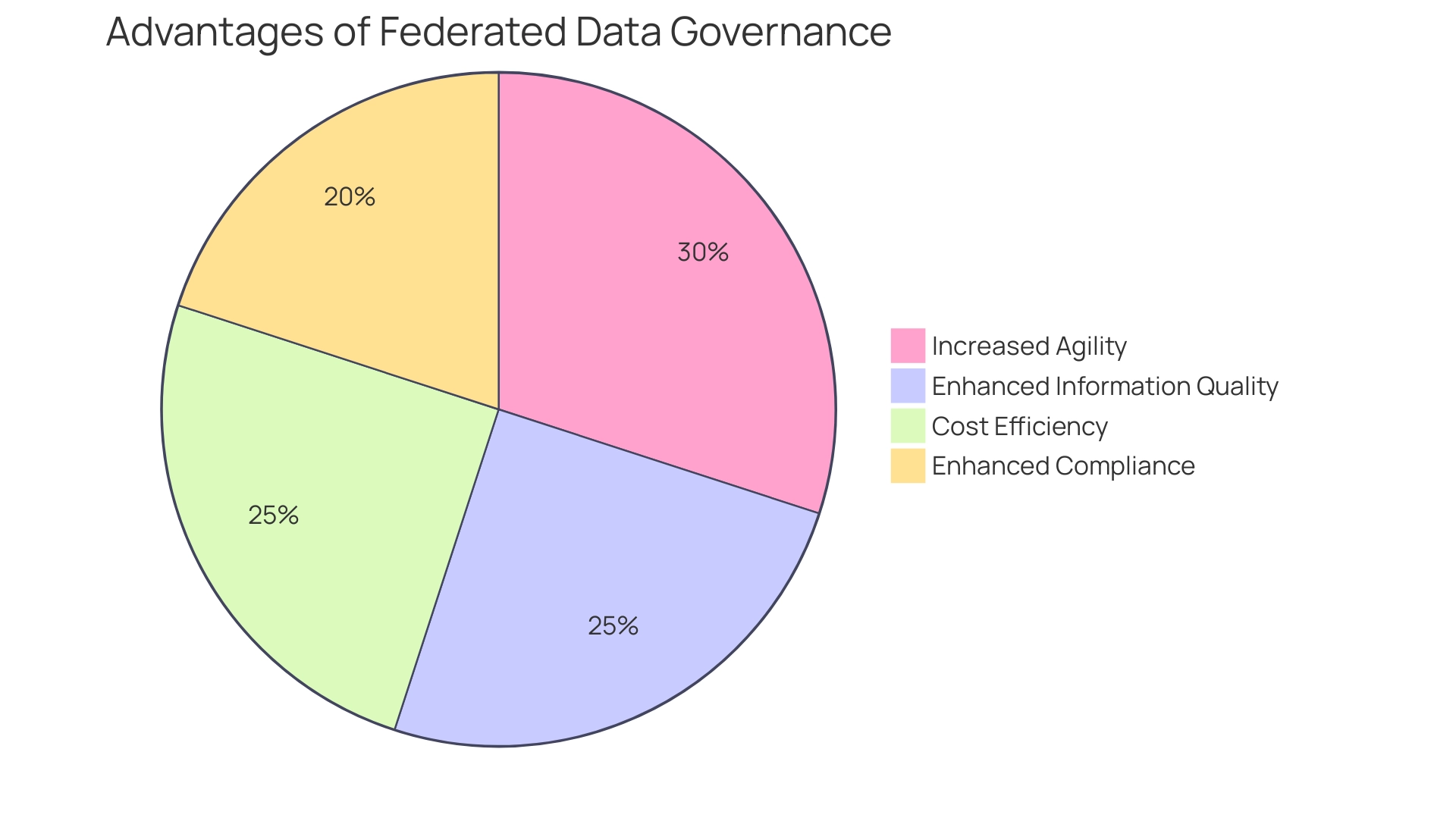
Assigning Roles and Responsibilities in Federated Data Governance
To implement federated data governance effectively, organizations must clearly define and assign specific roles and responsibilities that foster accountability and enhance data management practices.
-
Data Domain Owners are pivotal in ensuring the quality and compliance of data within their respective domains. They play a crucial role in balancing flexibility with compliance, particularly in sectors like finance, where effective management aids in fraud detection efforts. This balance is essential for navigating the complexities of the financial landscape.
-
Information Stewards oversee information management practices, ensuring compliance with regulatory policies regarding federated data. Their responsibilities include monitoring information quality and facilitating effective utilization of this information, which is essential for informed decision-making and organizational growth. According to Mathias Vercauteren, “With a solid data management operating model, your organization is better equipped to handle data challenges, make informed decisions based on accurate data, and drive growth through the effective utilization of data.”
-
Central Governance Team provides crucial support and guidance to local teams, ensuring that all management efforts align with organizational standards. Their role is essential in bridging gaps between isolated teams, which can create bottlenecks in management initiatives. Addressing these bottlenecks is crucial for effective collaboration across departments.
-
Information Users engage with information in their daily operations and require comprehensive training and awareness of governance policies. Their understanding of these policies is vital for maintaining compliance and ensuring effective data utilization. Investing in comprehensive training programs related to Avato’s hybrid integration platform, along with implementing change management strategies, will ensure that staff are comfortable with the new platform and foster a culture of innovation within the company.
Defining these roles not only clarifies responsibilities but also improves collaboration across departments, ensuring that all team members are aligned with the federated data management objectives of the entity. As entities manage the intricacies of information management in 2025, the significance of designating distinct roles and responsibilities cannot be overstated. By utilizing catalogs of information and quality monitoring tools, organizations can track key performance indicators (KPIs) that align with their business objectives, ultimately delivering measurable business value from their management initiatives.
This involves defining KPIs that assess quality enhancements and compliance rates, which are crucial for evaluating the effectiveness of training and change management strategies. Moreover, Avato’s dedication to guaranteeing 24/7 uptime for essential integrations highlights the importance of dependable information management in the banking industry.
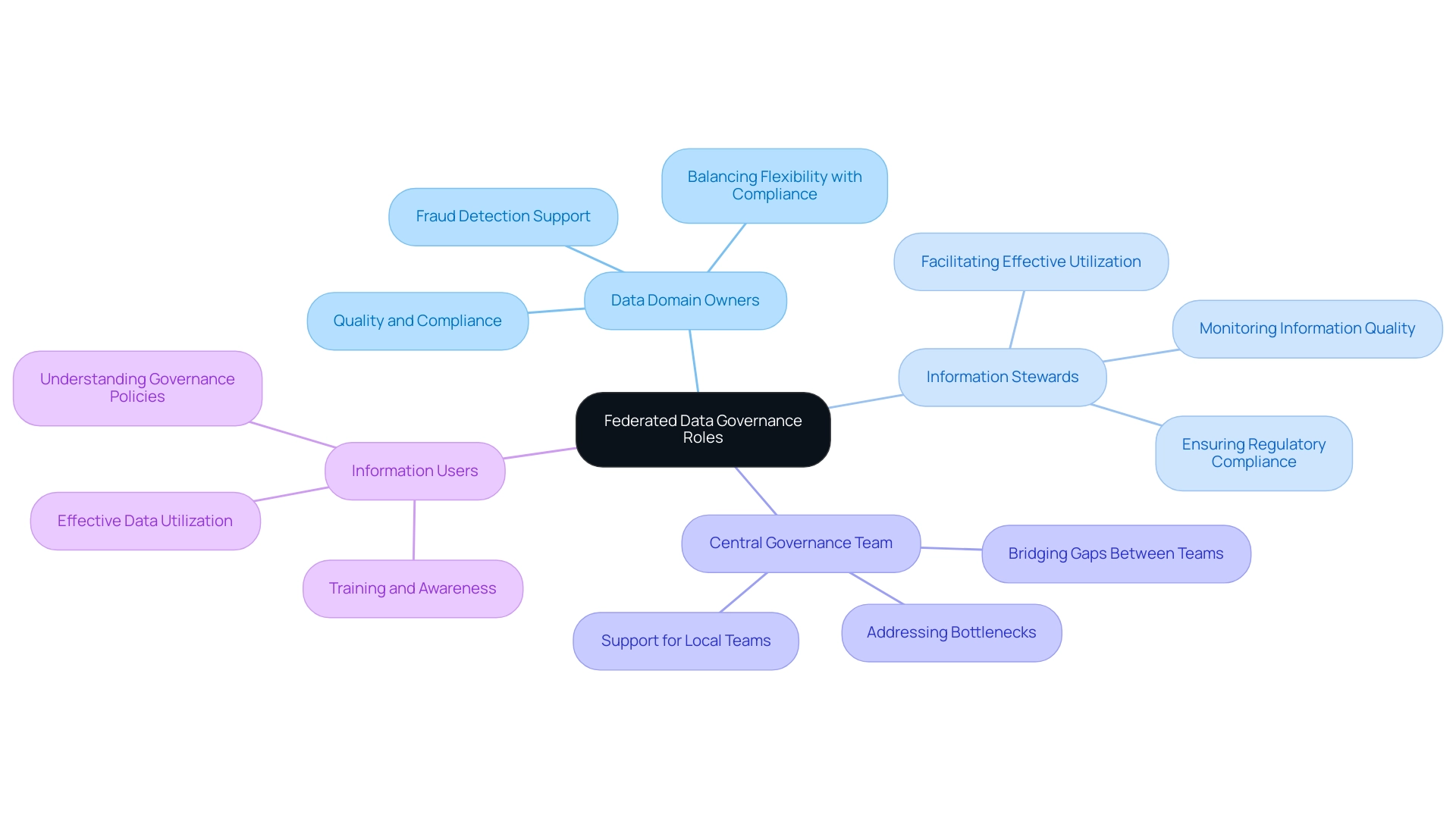
Defining the Scope and Goals of Your Federated Data Governance Program
Establishing the boundaries and objectives of your federated data management initiative is essential for its success.
-
Identify Key Stakeholders: Engage with stakeholders across various departments to gather insights into their information needs and concerns. This engagement fosters a collaborative environment and ensures that the management program addresses the diverse needs of the organization.
-
Set Clear Objectives: Establish specific, measurable goals that align with organizational priorities. For instance, objectives may include improving information quality, enhancing compliance with regulations, or increasing operational efficiency. Clear objectives not only guide the program but also facilitate stakeholder buy-in.
-
Determine Scope: Define the boundaries of the management program. This includes identifying which information domains will be governed and the extent of the policies that will be implemented. A well-defined scope aids in managing resources efficiently and ensures that the oversight efforts are focused and impactful.
-
Communicate Goals: It is essential to ensure that all stakeholders are informed about the program’s objectives and their respective roles in achieving them. Effective communication promotes accountability and encourages active involvement in the management process. Establishing a strong information culture is crucial for gaining organizational support and acknowledging the advantages of information oversight. In 2025, statistics suggest that entities with involved stakeholders in their information management initiatives experience a notable rise in program efficiency. Successful federated data governance programs are characterized by clear objectives, defined scopes, and active stakeholder engagement, which collectively contribute to improved federated data management and continuity across the organization. Furthermore, leveraging Avato’s hybrid integration platform, which ensures 24/7 uptime for critical integrations, can significantly enhance the reliability of your federated data governance program.
As mentioned by Gustavo Estrada, a customer, Avato simplifies complex projects and delivers results within desired time frames and budget constraints, making it an invaluable asset for firms in the banking sector. Additionally, Avato’s focus on structured requirements management assists entities in modernizing legacy systems, ensuring compliance and efficiency in regulated industries. Avato offers a comprehensive range of services, including enterprise architecture, solutions architecture, infrastructure architecture, business analysis, technical analysis, project management, interface design and development, software development, and quality assurance.
Considering the growing importance of information management in large organizations, especially in the financial industry, creating an information culture and involving stakeholders is more essential than ever.
- Contact Us to learn more about how Avato can support your digital transformation journey.
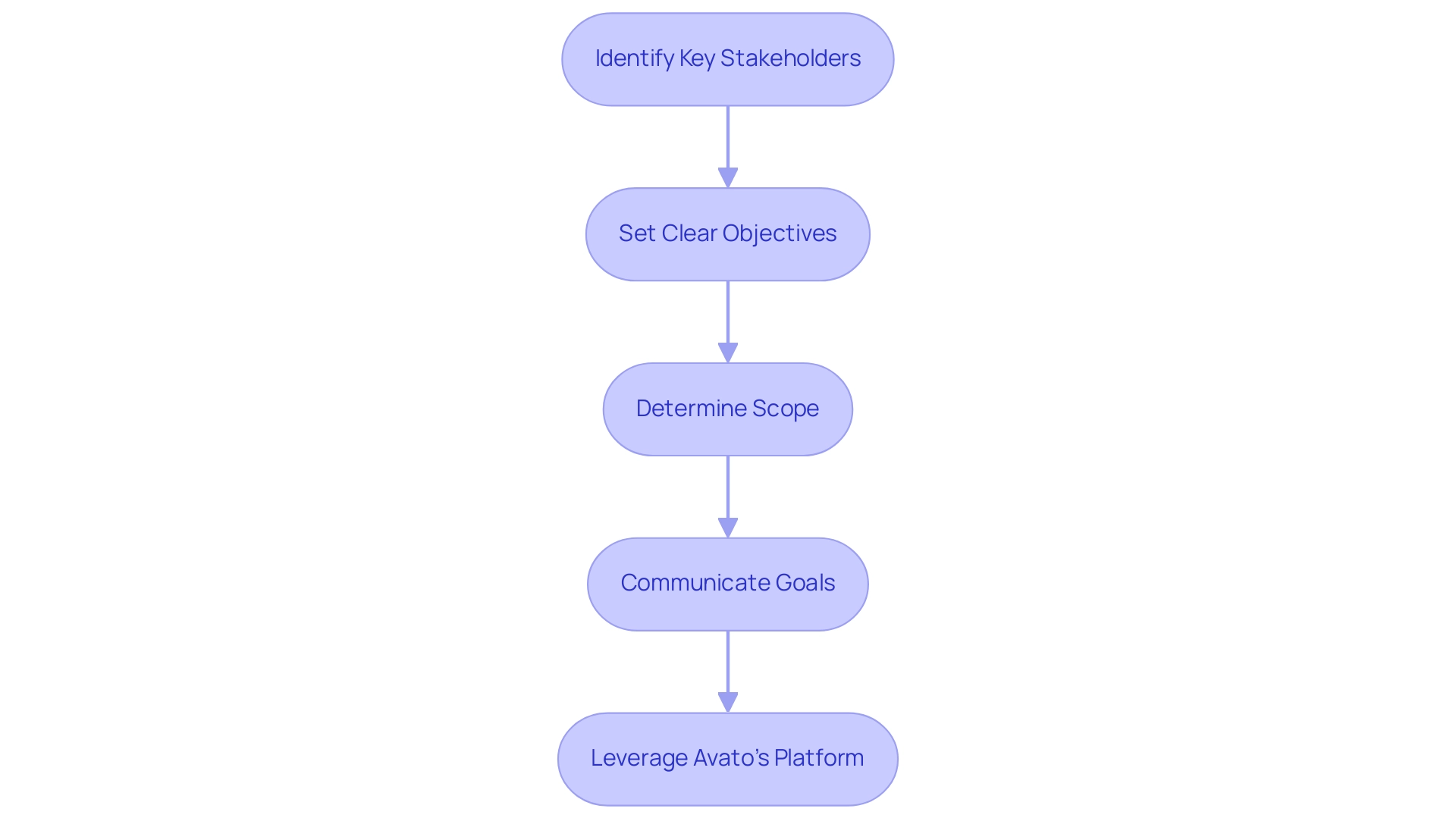
Developing a Framework for Federated Data Governance Implementation
To establish a robust framework for federated data governance implementation, organizations must follow a structured approach that addresses critical steps:
- Assess Current Status: Begin by thoroughly evaluating existing information management practices. This assessment will uncover gaps and weaknesses that require attention to ensure compliance with evolving regulations and organizational needs.
- Define Oversight Policies: Develop clear oversight policies that delineate information management practices, compliance requirements, and quality standards. These policies should align with industry best practices while being tailored to the specific needs of the organization, ensuring all stakeholders comprehend their roles and responsibilities. As highlighted by NetHope, “Information management is the essential foundation to ensuring that content is consistent, reliable, and doesn’t get misused.”
- Select Tools and Technologies: Identify and implement tools that will facilitate management efforts. This may include information catalogs, quality management systems, and metadata management platforms. The right technology can streamline processes and enhance data visibility, which is crucial for effective management.
- Create a Communication Plan: Formulate a comprehensive communication strategy to disseminate policy updates and information to all stakeholders. Effective communication fosters a culture of accountability and ensures everyone is informed about initiatives and their significance.
- Monitor and Adjust: Establish mechanisms for ongoing monitoring of management effectiveness. Regularly review and adjust policies and practices based on feedback and performance metrics. This iterative approach enables organizations to remain adaptable and responsive to changes in information environments and regulatory requirements.
A well-organized structure guarantees that federated data management initiatives are executed uniformly and efficiently, enhancing the entity’s ability to manage information responsibly. As emphasized by industry insights, a strong information management framework should encompass a needs assessment, stakeholder matrix, and key performance indicators to measure success. Notably, with 31% of firms in the pharmaceutical sector fully adopting management strategies, it is evident that entities across diverse industries recognize the vital importance of efficient information oversight in today’s information-driven landscape.
By learning from successful case studies, such as Tide’s compliance with GDPR, where the adoption of a metadata platform significantly reduced a 50-day manual process to mere hours, organizations can embrace best practices that enhance information security and operational efficiency. Furthermore, the Equifax breach underscores the necessity of clear responsibility and information inventory in preventing management failures, making it essential for entities to prioritize strong information management frameworks.
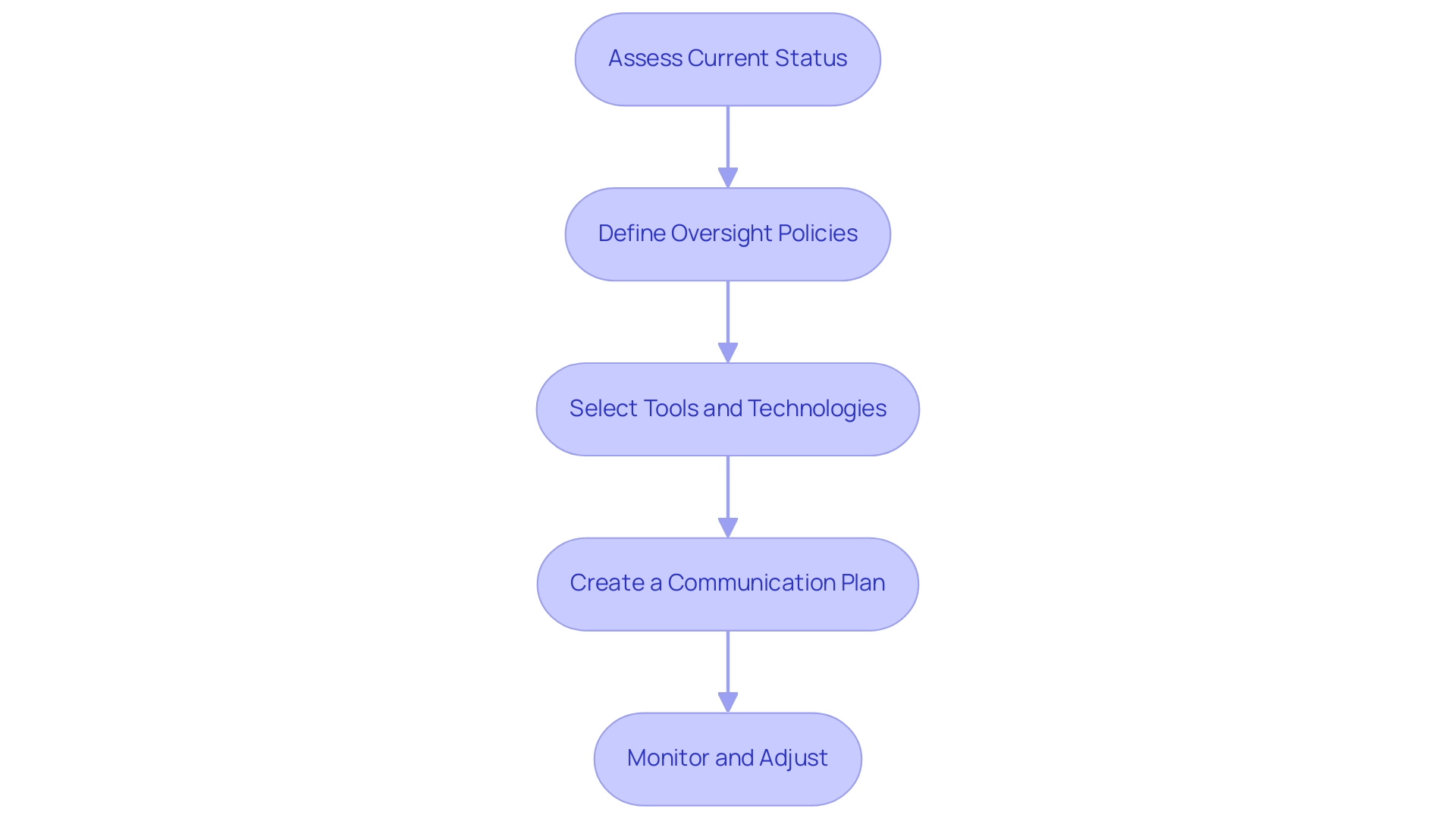
Establishing Quality Standards for Federated Data Governance
To establish quality standards for federated information governance, organizations must take decisive steps:
- Define Quality Metrics: Identify essential metrics for assessing quality, such as accuracy, completeness, consistency, and timeliness. These metrics serve as benchmarks for evaluating the integrity of information across various sources.
- Implement Information Quality Processes: Develop comprehensive processes to monitor and enhance information quality. This includes conducting regular audits, performing cleansing activities, and utilizing automated tools to detect anomalies and inconsistencies in real-time. Avato’s hybrid integration platform ensures 24/7 uptime for critical integrations, underscoring the necessity of reliability in these processes and simplifying the management of disparate systems.
- Engage Stakeholders: Actively involve information domain owners and end-users in defining quality standards. Their insights ensure that the standards are not only practical but also aligned with the operational realities of the organization.
- Communicate Standards: Clearly articulate the established quality standards to all stakeholders. Providing training and resources on how to meet these standards is crucial for fostering a culture of information quality within the organization.
Establishing strong quality standards is essential for ensuring the reliability and trustworthiness of information within a federated data management framework. As we approach 2025, organizations increasingly depend on information-driven decisions to reduce expenses and enhance efficiency; thus, the significance of proper information management cannot be overstated. A recent survey revealed that 54% of participants recognized information management as a major challenge in maintaining integrity, second only to quality itself, as noted by Rachel Galvez.
This highlights the challenges organizations face in managing diverse information sources and emphasizes the need for a systematic approach to quality metrics. Furthermore, the case study titled ‘Data Governance Review‘ provides valuable insights into key concepts, frameworks, and maturity assessment models that can aid organizations in their leadership initiatives. By adopting these standards, organizations can significantly enhance their operational performance and ensure compliance with evolving regulatory requirements, ultimately leveraging Avato’s dedicated platform to empower their information management strategies.
Avato, meaning ‘of dedication’ in Hungarian, embodies a commitment to architecting the technology foundation necessary to power rich, connected customer experiences.
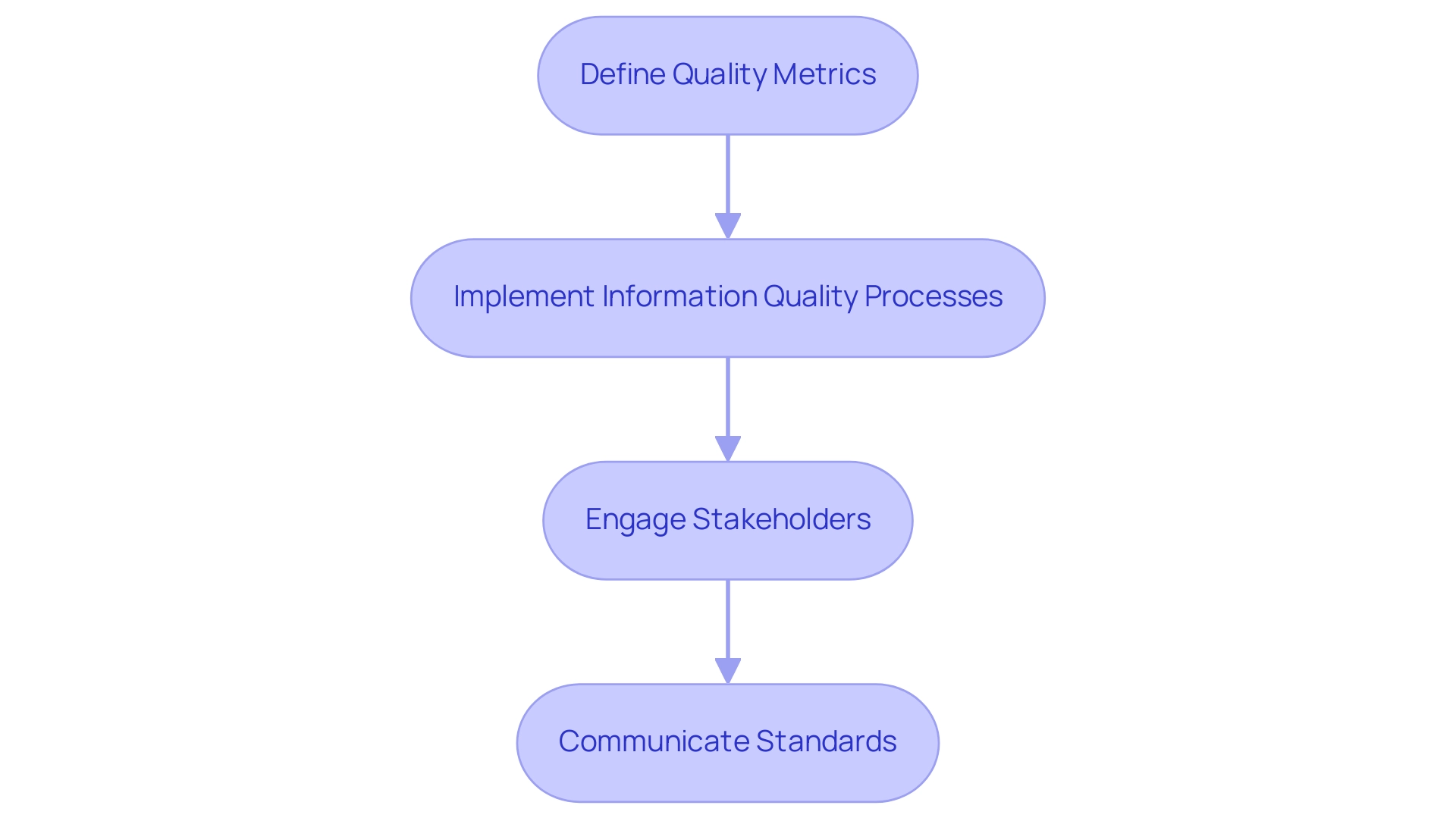
The Role of Data Catalogs in Federated Data Governance
Data catalogs are indispensable in the realm of federated data governance, serving multiple essential functions.
-
Enhancing Discoverability: Acting as a centralized repository for metadata, data catalogs significantly improve users’ ability to locate and access data assets. This streamlined discoverability is crucial in today’s data-driven environments, where timely access to information can drive strategic decision-making.
-
Supporting Information Quality: Information catalogs play a vital role in maintaining high quality standards. They meticulously track information lineage and quality metrics, enabling organizations to identify and rectify issues proactively. This emphasis on information quality is increasingly recognized as essential for successful AI implementations and comprehensive management strategies. As Gustavo Estrada observed, “Avato has the ability to simplify complex projects and deliver results within desired time frames and budget constraints,” emphasizing the effectiveness of catalogs in enhancing quality and collaboration.
-
Facilitating Collaboration: These catalogs promote cooperation across various information domains by offering a shared understanding of resources and their usage. This cooperative atmosphere is vital for entities seeking to utilize their information thoroughly and efficiently, especially within intricate regulatory frameworks.
-
Ensuring Compliance: Data catalogs assist organizations in tracking adherence to policies and regulatory requirements. With information sovereignty emerging as a key challenge for multinational companies in 2024, the ability to track compliance through a robust catalog system is more critical than ever. Integrating an information catalog into your federated data oversight approach is not only advantageous; it is crucial for effective management and compliance.
As organizations prepare for emerging trends, such as agentic AI, the role of information catalogs will only increase in significance, positioning them as a cornerstone of contemporary information management strategies. Furthermore, Avato, through its hybrid integration platform, guarantees 24/7 availability for essential integrations, highlighting the dependability required for effective information management.
The case study titled ‘The Role of Information Catalogs in Data Management’ illustrates how information catalogs enhance transparency and accessibility of information, improve quality and consistency, and facilitate compliance with privacy regulations, thereby becoming a foundational element of modern information management strategies. Avato was founded by a group of enterprise architects dedicated to solving complex integration challenges, embodying the company’s commitment to architecting the technology foundation required to power rich, connected customer experiences.
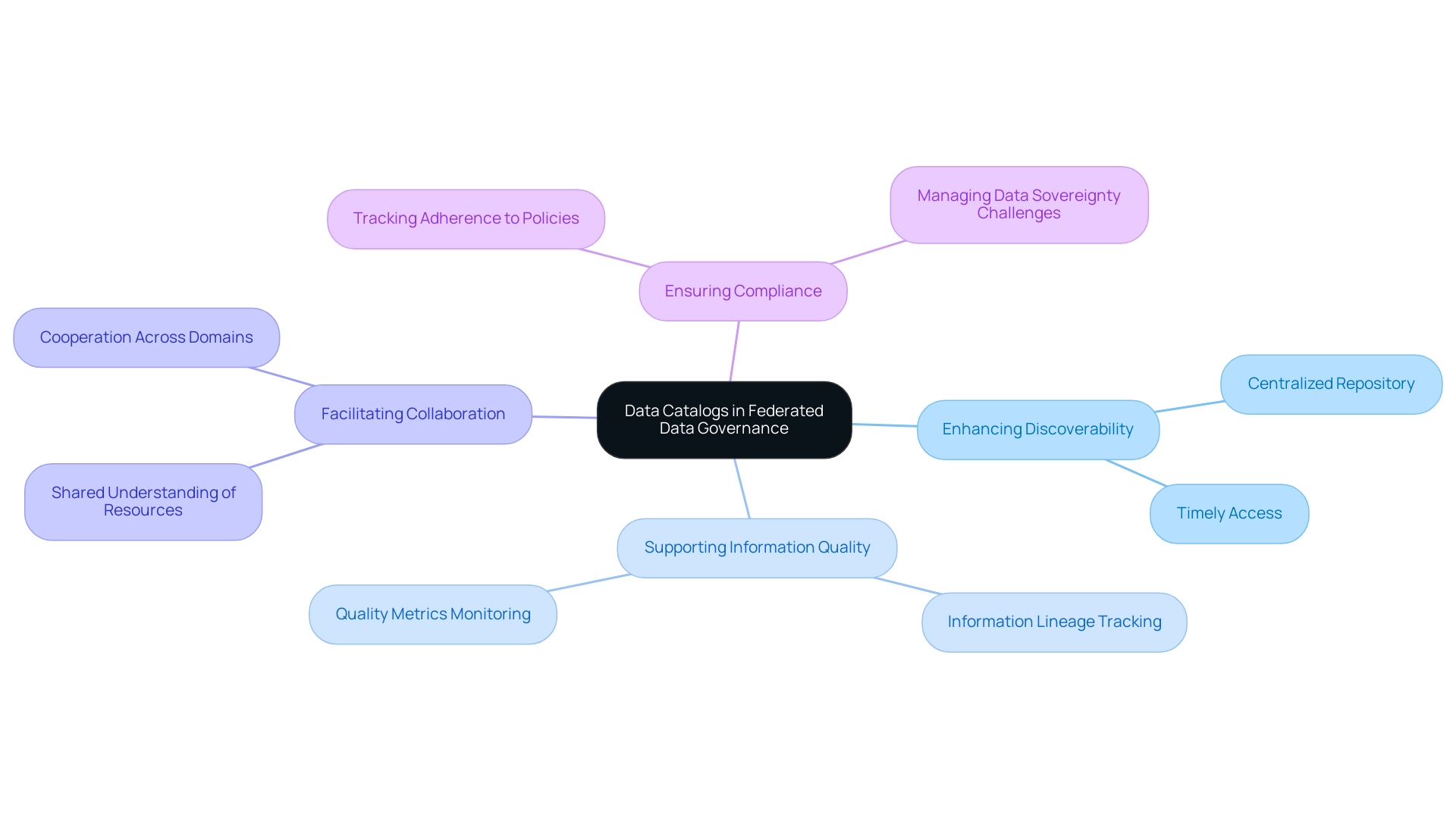
Establishing Clear Lines of Communication in Federated Data Governance
To establish clear lines of communication in federated data governance, organizations must consider several critical strategies:
-
Define Communication Channels: It is imperative to identify and establish the most effective channels for sharing information, such as email, intranet platforms, or collaboration tools. This ensures that all stakeholders have timely access to the necessary information.
-
Regular Updates: Organizations should schedule consistent updates to keep stakeholders informed about management initiatives, policy changes, and information quality metrics. Consistent communication is essential, especially as the proportion of respondents identifying data management as a top challenge surged from 27% in 2023 to 54% in recent surveys. This proactive approach mitigates risks associated with compliance and fraud detection in regulated sectors like finance and healthcare.
-
Feedback Mechanisms: Implementing structured feedback systems is crucial, allowing stakeholders to express their views on management practices and suggest improvements. This fosters a culture of collaboration and enhances the management framework by incorporating diverse perspectives.
-
Training and Awareness: Conducting comprehensive training sessions is vital to ensure that all team members understand their roles within the management framework and the significance of effective communication. Investing in training programs equips teams with the knowledge needed to navigate regulatory challenges and fosters a culture of innovation. As trends for 2025 indicate a growing emphasis on accountability and ethical practices in information management, these training initiatives become even more critical.
The case study titled “The Future of Governance” underscores the importance of embracing advanced technologies and ethical practices in information management, particularly in regulated sectors such as healthcare and finance. Effective communication is essential for promoting collaboration and ensuring that all stakeholders are aligned with organizational objectives regarding federated data. As Gustavo Estrada noted, Avato simplifies complex projects and delivers results within desired time frames and budget constraints, reinforcing the effectiveness of these communication strategies.
By prioritizing these strategies, organizations can significantly enhance their collaborative information management efforts, ultimately resulting in improved operational outcomes and compliance adherence.
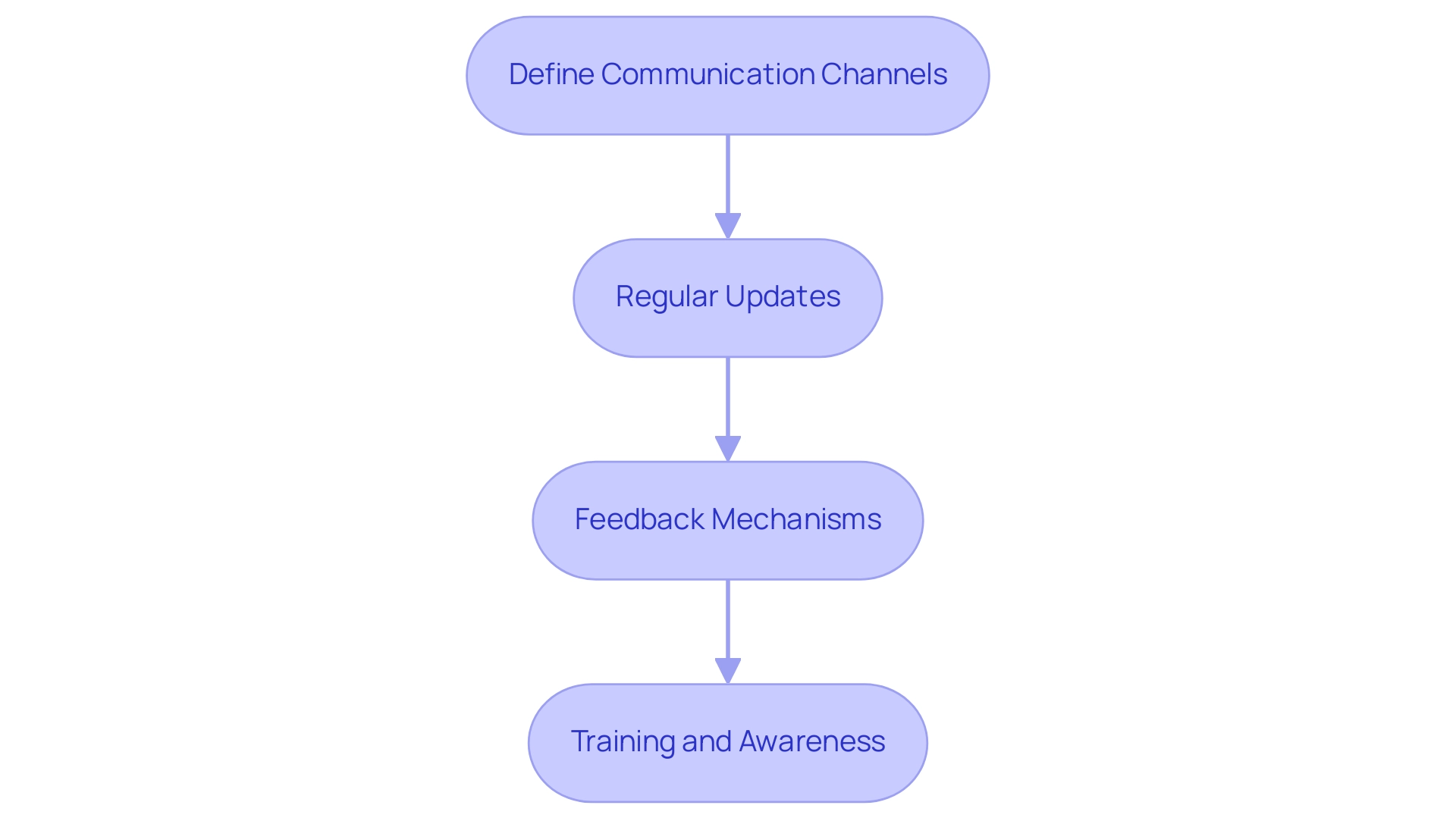
Training Your Team for Successful Federated Data Governance Implementation
To effectively prepare your team for the successful implementation of federated information management, consider the following strategies:
-
Develop Comprehensive Training Programs: Establish training programs that encompass management policies, information quality standards, and the use of catalogs. This foundational knowledge is essential for all team members to grasp the framework within which they will operate.
-
Tailor Training to Specific Roles: Customize training content to address the unique needs and responsibilities of various roles within the organizational structure. This approach ensures that each team member receives relevant information that directly applies to their functions, thereby enhancing their engagement and effectiveness.
-
Provide Continuous Assistance and Resources: Establish a system for ongoing support that keeps team members informed about evolving management practices and information handling tools. Continuous learning opportunities are vital, as they help maintain a knowledgeable workforce capable of adapting to new challenges.
-
Promote a Culture of Information Management: Cultivate an organizational environment that emphasizes the importance of information quality and adherence to regulations. Encouraging open discussions about management practices can lead to a more informed and proactive team.
-
Leverage Avato’s Technology Stack: Utilize Avato’s reliable hybrid integration platform, designed for secure transactions and trusted by industries such as banking, healthcare, and government, to bolster your collective information management initiatives. This technology not only aids in adapting to evolving demands but also enhances operational capabilities, ensuring that your management framework is robust and future-proof. Furthermore, Avato’s collaborations with managed service providers worldwide enable a complete team to execute your information transformation project or augment your internal team as needed.
Effective training is not merely a singular occurrence; it is an ongoing process that empowers your team to contribute significantly to the success of your federated data management initiative. With 92% of workers believing that workplace training positively impacts job engagement, investing in tailored training programs can significantly enhance your team’s performance and commitment to governance objectives. Furthermore, testimonials from clients like Tony Leblanc of the Provincial Health Services Authority highlight the professionalism and expertise of Avato’s team, showcasing the effectiveness of their services in real-world applications.
The Data Governance Program case study illustrates how structured training can equip professionals with the necessary skills to manage data effectively, ultimately improving their career prospects in the technology and data fields.
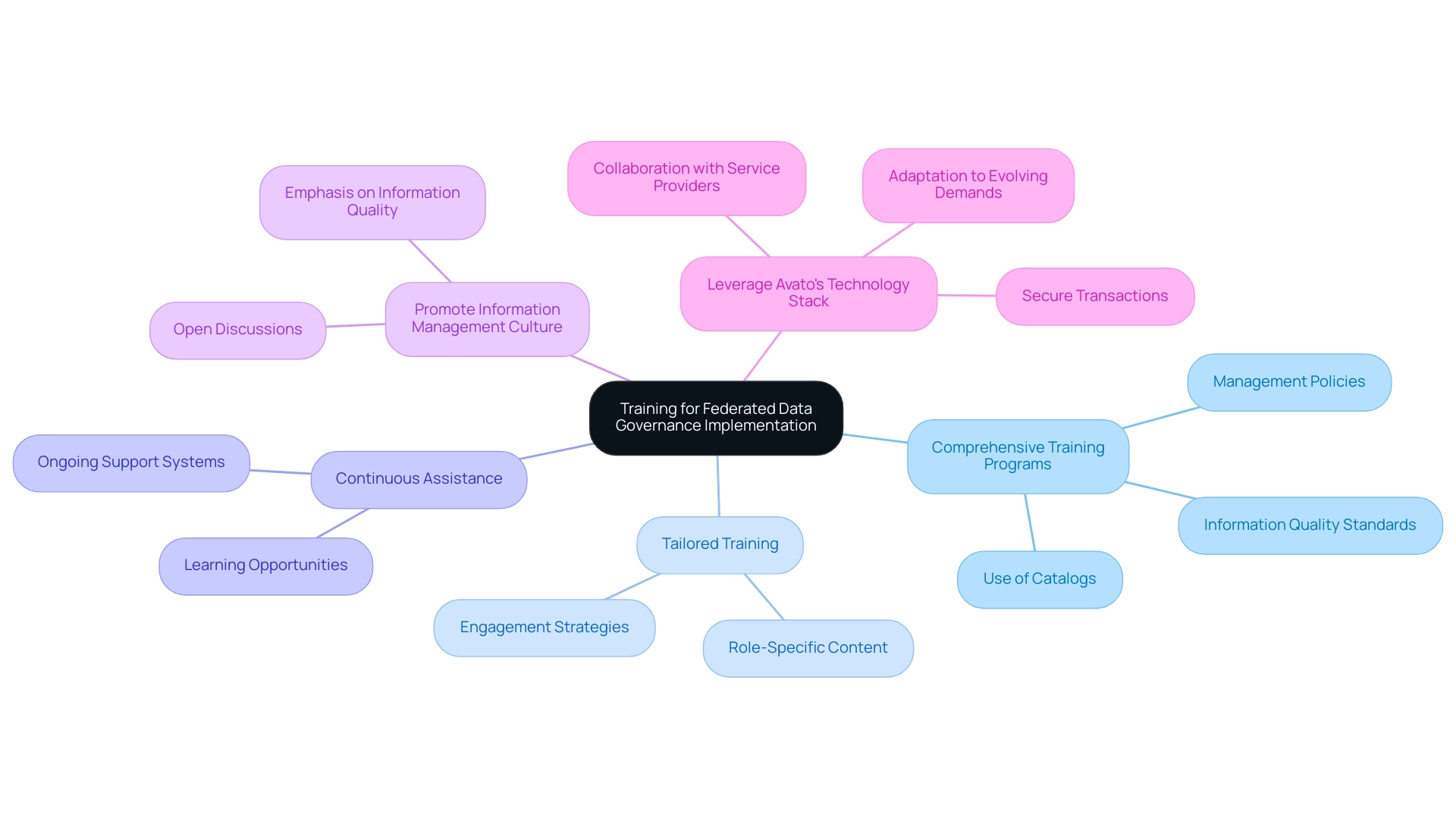
Conclusion
Implementing federated data governance is not just a strategic choice; it signifies a critical evolution in how organizations manage their data assets in a complex and rapidly changing landscape. By decentralizing data management, businesses gain the agility to respond to local needs while ensuring compliance with overarching governance policies. Key concepts such as data ownership, decentralization, and collaboration are essential for fostering a culture of accountability and enhancing operational efficiency.
The advantages of adopting a federated governance model are compelling. Organizations can experience significant returns on investment, improved data quality, and enhanced compliance tailored to specific regulatory requirements. This approach minimizes operational costs while empowering local teams to make decisions that align with their unique business contexts, ultimately leading to better overall performance.
As organizations navigate the intricacies of implementing federated data governance, the importance of defining roles, establishing clear communication channels, and fostering a culture of training and support cannot be overstated. By ensuring alignment among all stakeholders with governance objectives, companies drive success in their data management initiatives.
In conclusion, federated data governance is a powerful framework that enables organizations to leverage their data more effectively. By prioritizing this approach, businesses can meet current regulatory demands and position themselves for future opportunities in an increasingly data-driven world. Embracing the principles of federated governance facilitates a more resilient, responsive, and responsible data management strategy that adapts to ongoing changes in technology and regulation.

